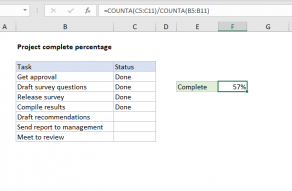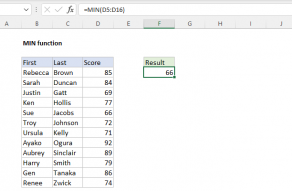Explanation
The MINIFS function returns the smallest numeric value that meets supplied criteria, and the MAXIFS function returns the largest numeric value that meets supplied criteria.
Like COUNTIFS and SUMIFS, these functions use range/criteria "pairs" to apply conditions. For both formulas, we need just one condition: the project name must equal the name in column G:
data[Project],G5 // condition
To get the earliest start date, we use:
=MINIFS(data[Start],data[Project],G5) // earliest date
Here, MINIFS returns the minimum value in the Start column where the project is equal to "Omega" (from cell G5). Since Excel dates are just numbers, the minimum date is the same as the earliest date.
To get the latest end date, we use:
=MAXIFS(data[End],data[Project],G5) // latest date
Here, MAXIFS returns the maximum value in the End column where the project is equal to "Omega". As above, the maximum value is the same as the latest date.
Array formula alternative
If you don't have MINIFS and MAXIFS, you can use simple array formulas, based on the MIN and MAX functions, to get the same result. For the earliest start date:
{=MIN(IF(data[Project]=G5,data[Start]))}
For the latest end date:
{=MAX(IF(data[Project]=G5,data[End]))}
Note: both formulas are array formulas and must be entered with control + shift + enter, in Excel 2019 or earlier. With Excel 365, you can enter the formulas normally, since array formulas are native.
In both cases, the IF function is used to "filter" date values like this:
IF(data[Project]=G5,data[End]) // filter dates by project
When G5 is "Omega", IF returns the end date. Otherwise, IF returns FALSE. Since we are testing all project names in the table at the same time, the result is an array of values like this:
{43936;43983;43990;FALSE;FALSE;FALSE;FALSE;FALSE;FALSE;FALSE;FALSE;FALSE}
The large serial numbers are Excel dates associated with project Omega. The other values are FALSE, since the project is not Omega. Because MIN and MAX are programmed to ignore the logical values TRUE and FALSE, they only operate on the remaining values. MIN returns the smallest (earliest) date, and MAX returns the largest (latest) date.
















